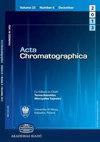多因素统计分析不同产地唐古特山莨菪碱生物碱的地理来源
IF 1.7
4区 化学
Q3 CHEMISTRY, ANALYTICAL
引用次数: 2
摘要
唐古特山莨菪碱是西藏重要的民间药材,也是青藏高原生长的莨菪生物碱的来源。唐古特A.tanguticus在不同地理区域的质量存在显著差异。本研究的目的是建立一种TAs的定量分析方法,结合化学计量学分析来追踪地理来源。采用超高效液相色谱-四极杆飞行时间质谱联用技术对唐古特A.tanguticus中的TAs进行了定性分析,并对不同地理来源的不同植物器官中的TAs进行了定量分析。对TA的含量进行主成分分析和正交偏最小二乘判别分析。山莨菪碱、山莨菪碱和阿托品这三种标志性化合物在唐古特A.tanguticus根和肢端的含量呈正相关,不同地理来源的含量差异显著。主成分分析和正交偏最小二乘判别分析结果表明,唐古特A.tanguticus在不同地理来源之间具有良好的鉴别能力。本研究可为唐古特A.tanguticus资源的综合评价和进一步利用提供依据。本文章由计算机程序翻译,如有差异,请以英文原文为准。
Multivariate statistical analysis of tropane alkaloids in Anisodus tanguticus (Maxim.) Pascher from different regions to trace geographical origins
Anisodus tanguticus (Maxim.) Pascher is an important Tibetan folk medicine and the source of tropane alkaloids (TAs) grown in Qinghai-Tibet Plateau. There are marked differences in quality of A. tanguticus from geographic areas. The aim of present research was to establish a method for the quantitative analysis of TAs coupled with chemometrics analysis to trace geographical origins. Qualitative analysis of TAs in A. tanguticus was carried out using ultra-performance liquid chromatography coupled with quadrupole time-of-flight mass spectrometry and quantitative analysis of TAs in different plant organs from different geographical origin was achieved. Contents of TAs were subjected to the principal component analysis, and orthogonal partial least-squares discriminant analysis. The contents of the three marker compounds (anisodamine, anisodine and atropine) in the roots and acrial parts of A. tanguticus were positive correlated and varied significantly from different geographical origins. Principal component analysis, and orthogonal partial least-squares discriminant analysis results showed excellent discrimination between different geographical origin of A. tanguticus. This study could provide comprehensive evaluation and further utilization of A. tanguticus resources.
求助全文
通过发布文献求助,成功后即可免费获取论文全文。
去求助
来源期刊

Acta Chromatographica
化学-分析化学
CiteScore
4.00
自引率
0.00%
发文量
55
审稿时长
2.3 months
期刊介绍:
Acta Chromatographica
Open Access
Acta Chromatographica publishes peer-reviewed scientific articles on every field of chromatography, including theory of chromatography; progress in synthesis and characterization of new stationary phases; chromatography of organic, inorganic and complex compounds; enantioseparation and chromatography of chiral compounds; applications of chromatography in biology, pharmacy, medicine, and food analysis; environmental applications of chromatography; analytical and physico-chemical aspects of sample preparation for chromatography; hyphenated and combined techniques; chemometrics and its applications in separation science.
 求助内容:
求助内容: 应助结果提醒方式:
应助结果提醒方式:


